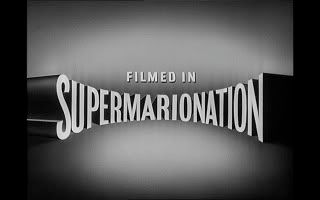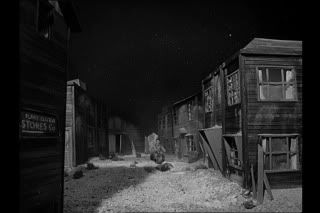

|
 |
Fireball XL5: The Complete Series
R2 - United Kingdom - Network Review written by and copyright: Paul Lewis (29th June 2009). |
|
The Show
  
Produced after the success of Gerry Anderson’s first science fiction-themed puppet series Supercar (APF/ITC, 1960-2), Fireball XL5 (APF/ITC, 1962) was the first of Anderson’s series to journey into the outer limits of space. The series revolves around the adventures of Colonel Steve Zodiac (Paul Maxwell), pilot of the space ship ‘Fireball XL5’; partners in Zodiac’s space-set adventures are Venus (the ship’s physician, voiced by Sylvia Anderson) and her ‘space pet’ Zoonie, the ship’s navigator Professor Matic (David Graham) and Zodiac’s co-pilot Robert the Robot (Gerry Anderson). Fireball XL5 was not only Anderson’s second science fiction series, but also his second series for Lew Grade; the working relationship between Anderson and Grade would eventually lead to the production of the later puppet series Stingray (APF/ITC, 1964-5), Thunderbirds (APF/ATV, 1965-6), Captain Scarlet and the Mysterons (Century 21/ITC, 1967) and Joe 90 (Century 21/ITC, 1968). Fireball XL5 was Anderson’s third ‘Supermarionation’ show, after the aforementioned Supercar and its predecessor, the Western series Four Feather Falls (Granada, 1960); however, as the term ‘Supermarionation’ was not used until the production of Supercar, Four Feather Falls is often excluded from discussions of the Supermarionation process. 
Set in the years 2062-3, Fireball XL5 taps into the zeitgeist of the early-1960s, an era dominated by discourse about the ‘space race’ between the US and USSR, which began with the USSR’s launch of Sputnik 1 in 1957. The series also taps into the paranoia of the Cold War era, and Fireball XL5 features some especially creepy moments – thanks to the square-jawed Steve Zodiac and his crew’s exploration of unknown planets and encounters with unfamiliar enemies. Working for the World Space Patrol, the mission of Fireball XL5’s crew is to patrol an area in space known as ‘Sector 25’; other ‘XL’ craft patrol different sectors in space. The crew’s orders are delivered by Commander Wilbur Zero (John Bluthal) of Space City; situated on Earth, Space City was a modernistic science facility, a precursor to Tracy Island in Thunderbirds. 
As in Anderson’s other series, there are some great comic moments: in one episode, a character describes Zodiac as ‘what the kid s say… “real boss”’. Fast-moving, like Anderson’s other series Fireball XL5 has a heavy focus on action. This aspect of the series was reinforced through Barry Gray’s strident and almost militaristic scoring; Gray would compose the music for later Anderson series, including Captain Scarlet and the Mysterons, Thunderbirds, Joe 90 and Space: 1999 (ITC, 1975-7). Although ostensibly a science fiction series, Fireball XL5 also refers back to the Western-themed narratives of Four Feather Falls: in episode twenty-eight (‘1875’), Zodiac and his crew are sent back in time following an incident involving Professor Matic’s experimental time machine. The crew find themselves in a town in the Wild West, with Steve Zodiac taking the role of the town’s sheriff. Likewise, episode thirty-five (‘Ghosts of Space’) features Fireball XL5 dropping off an explorer named Fraser on Planet Electon. Fraser discovers a ghost town on the planet – a strange settlement which appears to be abandoned, complete with tumbleweed drifting across the empty streets. 
Disc One: 1. ‘Planet 46’ 2. ‘Hypnotic Sphere’ 3. ‘Planet of Platonia’ 4. ‘Space Magnet’ 5. ‘The Doomed Planet’ 6. ‘Plant Man From Space’ 7. ‘The Sun Temple’ 8. ‘Space Immigrants’ Disc Two: 9. ‘Space Monster’ 10. ‘Spy in Space’ 11. ‘Flying Zodiac’ 12. ‘XL5 to H20’ 13. ‘Space Pirates’ 14. ‘The Last of the Zanadus’ 15. ‘Convict in Space’ 16. ‘Space Pen’ Disc Three: 17. ‘Wings of Danger’ 18. ‘The Triads’ 19. ‘Sabotage’ 20. ‘Prisoner on the Lost Planet’ 21. ‘Flight to Danger’ 22. ‘Space Vacation’ 23. ‘Mystery of the Taz’ 24. ‘Robert to the Rescue’ Disc Four: 25. ‘The Forbidden Planet’ 26. ‘The Granatoid Tanks’ 27. ‘Dangerous Cargo’ 28. ‘1875’ 29. ‘The Robot Freighter Mystery’ 30. ‘The Day the Earth Froze’ 31. ‘Drama at Space City’ 32. ‘Whistle for Danger’ Disc Five: 33. ‘Faster Than Light’ 34. ‘Invasion Earth’ 35. ‘Ghosts of Space’ 36. ‘Trial By Robot’ 37. ‘A Day in the Life of a Space General’ 38. ‘Space City Special’ 39. ‘The Fire Fighters’ Disc Six: Documentary: ‘A Wonderland of Stardust’ (73:34) Documentary: ‘Drawn in Supermarionation’ (37:38) ‘A Day in the Life of a Space General’ (Colour Edition) (24:50) Bill Mevin’s Supercar Home Movie (Mute) (1:41) Zoom Ice Lolly Adverts (00:38) Images Gallery (7:38) Merchandise Gallery (6:08)
Video
The monochrome episodes are presented in their original broadcast screen ratio of 4:3 and look remarkably good, thanks in large part to being shot on 35mm film. The monochrome image is crisp and detailed, displaying good contrast. 
Audio
Audio is presented via a mono track (two-channel). Once again, this is very clear and crisp. However, there are no subtitles.
Extras
The sixth disc contains an array of contextual material, including: - ‘A Wonderland of Stardust’ (73:34). Narrated by Shane Rimmer, this documentary outlines the career of Gerry Anderson, from his first series Four Feather Falls to his later association with Lew Grade, which began with the series Supercar. The bulk of the documentary focuses on the production of Fireball XL5, featuring input from Gerry Anderson himself, his wife Sylvia Anderson, Keith Shackleton (the Director of Merchandising), directors David Elliott and Alan Pattillo, puppeteer and sculptor Mary Turner and a number of other figures associated with the production of Fireball XL5, who situate Anderson’s work within the ‘space race’ and the paranoia of the Cold War era. - ‘Drawn in Supermarionation’ (37:38). This documentary examines the relationship between post-war television and the medium of comic books. The documentary discusses the role of the publication TV Comic, described by artist Bill Mevin as ‘an upmarket television comic’ which featured strips focusing on Supermarionation series. The second half of the series examines the creation of TV Century 21, which became a ‘new home’ for many of the artists who had until then been associated with Eagle comic. The documentary contains comments from people such as comic artists Mike Noble and Colin Page. - ‘A Day in the Life of a Space General’ (Colour Edition) (24:50). This is a colourised version of the Fireball XL5 episode ‘A Day in the Life of a Space General’. The colourisation process is surprisingly effective. - ‘Bill Mevin’s Supercar Home Movie’ (Mute) (1:41). A home movie made by Bill Mevin, this short segment is silent and presents a view of the set of Supercar. - ‘Zoom Ice Lolly Adverts’ (00:38), two brief Fireball XL5-themed adverts for Lyon’s Maid Zoom Ice Lollies. - ‘Images’ (7:34), a gallery of promotional and behind the scenes images from the production of Fireball XL5. - ‘Merchandise’ (6:08), a gallery of vintage merchandise associated with Fireball XL5.
Overall
Fireball XL5 is a joy to watch, easily the equal of some of Anderson’s later series. This DVD set contains an amazing presentation of the episodes themselves, and a great range of contextual material. Therefore, this release comes with a very strong recommendation. For more information, please visit the homepage of Network DVD.
|
|||||

|